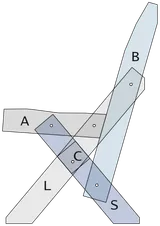Each bench has two leg frames at each end of the bench (and possibly more in the middle) to support the seat and backrest slats.
Each leg frame has two legs: a long forwards leg (L), and a short backwards leg (S),
as well as a seat rest (A), a backrest (B), and a center spacer (C) positioned between L and S.
The leg template is also used to position screw pilot holes on the slats (the long planks spanning the length of the bench).
Click on an images to view it in full-size.
Rests Template
Pieces
Positioning
Trace two A seat rests, two B backrests, and two C center spacers from the template onto your other 2x4x8.
The angled back sides of the A pieces should touch, as shown, to ensure all pieces fit.
On the template, the A pieces use the two innermost holes, while the B pieces use the two outermost holes.
The two A pieces must have their angled back sides touching.
The other pieces can be traced in any order.
Legs Template
Pieces
Each pieces has three (of the four) holes marked.
 |
|---|
The L long leg piece. Uses the full template. Mark the top three holes (furthest from the angled foot). |
If you plan to anchor your bench to the ground, also mark the two slits near the foot for aligning the mounting brackets.
Positioning
Trace two short S legs and two long L legs from the template onto your pressure-treated 2x4x8.
The angled foot cut of adjacent legs should touch, as shown, to ensure all pieces fit.
Each leg pieces uses three of the four template holes: the long leg uses the three holes closest to the top, and the short leg uses the three holes closest to the bottom.
The legs can be traced in any order, as long as the angled feet touch.
| Bench length | Hole dist (2 legs) | Hole dist (3 legs) |
|---|---|---|
| 4-5 ft. | 6 in. | x |
| 6 ft. | 12 in. | x |
| 7 ft. | 12 in.* | 6 in. |
| 8 ft. | 18 in.* | 12 in. |
| 10 ft. | x | 12 in. |
| 12 ft. | x | 12 in.* |
Slat Pilot Holes
We will need to drill pilot holes for the screws that will hold the slats to the leg frames. The leg frames need to be properly spaced to support the entire length of the bench; we should avoid any spans between slats greater than 5 ft. to prevent sagging.
The template has small pairs of holes which are 6, 12, and 18 in. from the end. The table to the right shows the recommended distance for each bench length. “Hole dist” is the distance from the end of the slat to the outer pilot holes. Options marked with an asterisk (*) require brace pieces in the middle of each span to prevent sagging. Brace pieces and third leg frames should be spaced evenly between the two outer frames.
Align the square end of the template with the end of the slat and find the correct pair of holes. Keep the drill vertical and use the small (3/32 to 1/8 in.) bit to drill each pilot hole. Each slat needs a pair of holes for each leg frame and brace piece, so for example 4-6 ft. benches need four holes, while 7-8 ft. benches need six holes.






